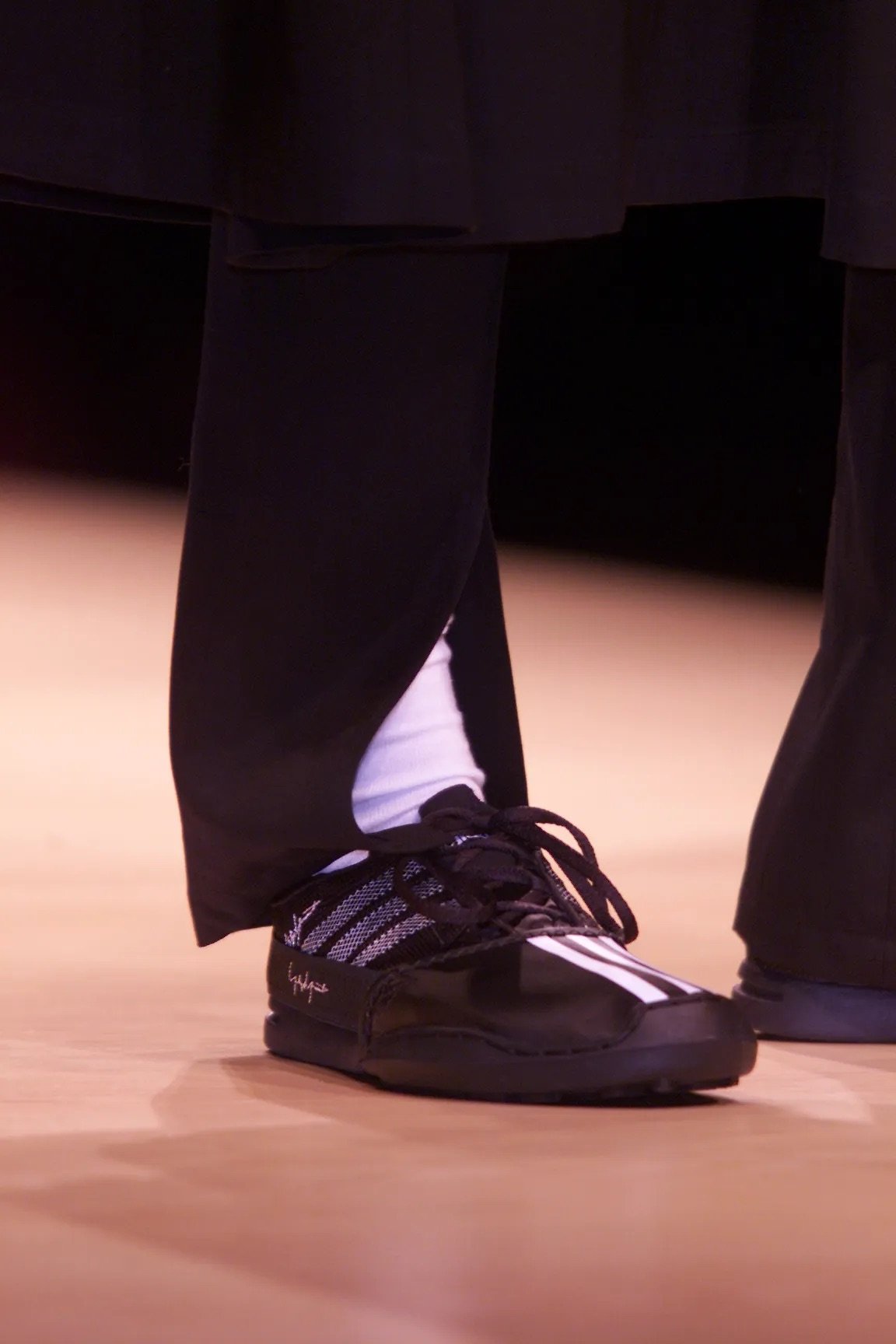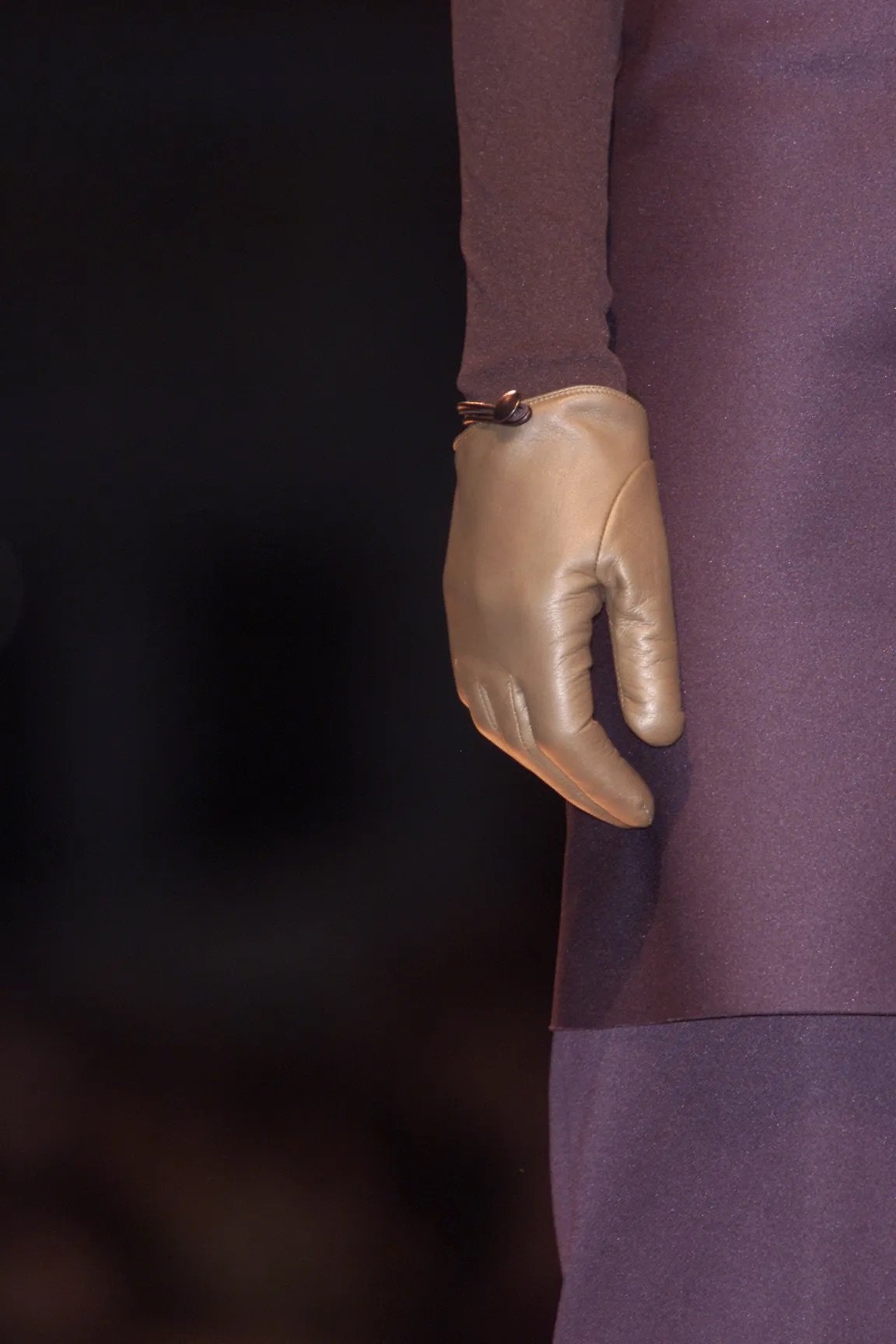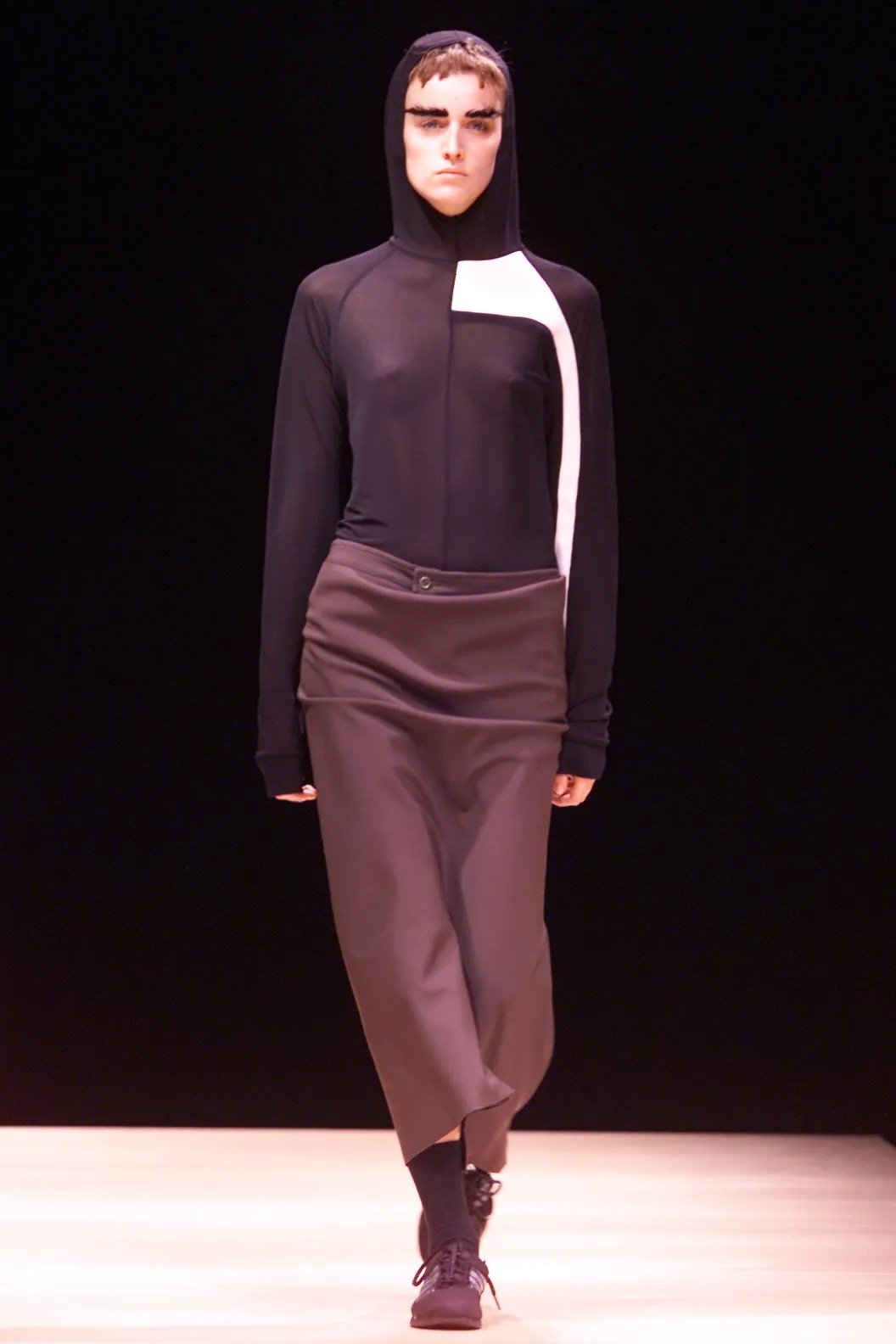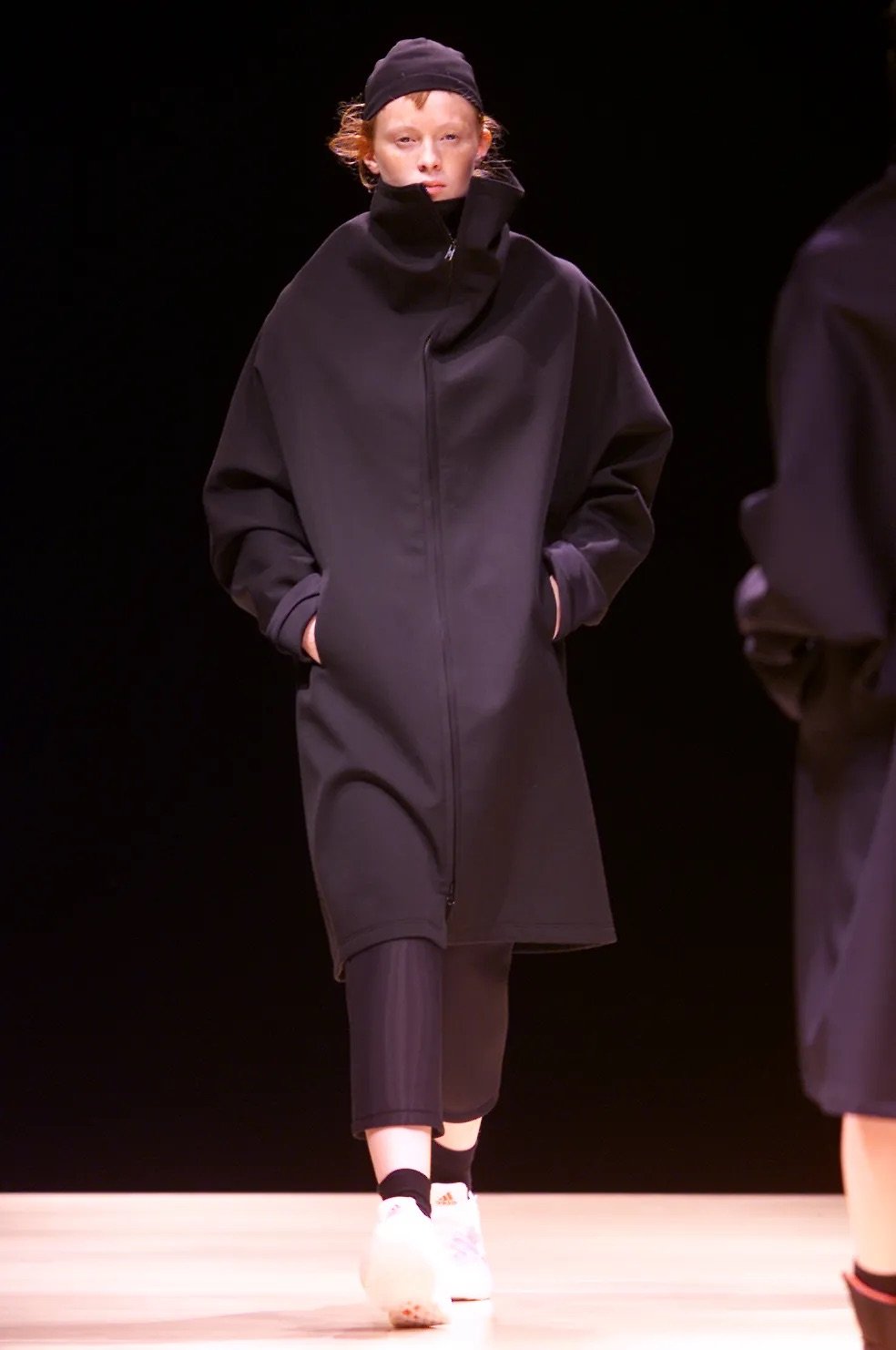Yohji Yamamoto
Autumn/Winter 2001-2002
Yohji Yamamoto Collections
2014
Yamamoto & Yohji
Published by Rizzoli
Sport and elegance? The answer is given by shaking up the basics: coded graphic stripes, drawstring waists, brought together with asymmetry, oversizing, wrappings. On the feet: Adidas for Yohji Yamamoto — deviants refined with silk and floral prints.
Yohji Yamamoto Fall 2001 Ready-to-Wear Collection
Vogue
Sporty Yohji? Jamais!
Think again—the Japanese master of fluid, dramatic silhouettes and couturelike craftsmanship proved that he can deliver plenty of surprises with a casual, athletic-inspired collection.
Naturally, this was no ordinary track-and-field uniform. Baseball-bomber blousons were designed to trap one of the arms of its wearer in its folds. Casual trousers came equipped with a short skirt overlay. A hooded baseball-inspired jacket was shown with a voluminous, ballooned floral-print skirt. And no Yamamoto show would be complete without artful draping: His long, amorphous coats revealed unexpected panels when least expected; asymmetric dresses exposed one arm and covered the other with a generous, flowing sleeve.
Yamamoto's accessories included visor sunglasses and velvety bags that doubled as scarves—but it's the colorful sneakers with red soles, silver racing stripes and floral designs that will have customers lining up next Fall.
Source unknown
Source unknown
Yohji Yamamoto Autumn/Winter 2001/2002 ready-to-wear collections
Getty Images
Photography by Jean-Pierre Muller
Yohji Yamamoto - Ready-to-Wear - Backstage Beauty and Fashion - Women: Fall / Winter 2001
firstView
2001-2002秋冬プレタポルテパリ・コレクション速報
Paris Prêt-à-Porter Collections 2001-2002 Autumn-Winter Report
June 2001
High Fashion No.279
Photography by Shin Shin and Koichiro Matsui
Report by Ikuko Fujii and Misako Tamagawa
ヴィレット・ホールの広い空間に音楽なしで繰り広げられたスポーツとクチュールのコラボレーション。クチュールテクニックを駆使したカットの服にアクティブスポーツメーカーのアディダスを象徴する白い3本線を大胆にはめ込み、バスケットシューズを履いたスポーツダンディズム。日本人ならではのアシメトリーな美意識をヨウジが好きなギャバジン、水泳やスキーウェア素材を使って紺、黒、カーキで描いた。彼本来のスタイルにスポーツという遊びを入れた作品。
A collaboration between sports and couture unfolded without music in the large space of the Villette Hall. Sports dandyism is seen in clothes cut using couture techniques, boldly inlaid with three white lines symbolizing active sports manufacturer Adidas, and wearing basketball shoes. The asymmetrical aesthetic unique to the Japanese is depicted in navy blue, black, and khaki using Yohji's favorite gabardine, swimming, and skiwear materials. This work is a play on his original style incorporating a touch of sports.
山本耀司 AtoZ
Yohji Yamamoto AtoZ
March 2011
FASHION NEWS Special Vol.161
Three Lines
3本線を征服するぞ!
テーラードマスターがなぜ「アディダス」?「今の気分の既製服に簡単に寄り添えるテーマとしてスポーツがぴったりだったから」と、当時の耀司。2001-02年秋冬コレクションは誰もが予想しなかった「アディダス」を題材として扱った。計算され緻密にカットされた布はダイナミックな弧を描き、スポーティな3本線がその曲線にそって優美なハーモニーを奏でる。もちろん、足にはコラボのスニーカー。「既製服のデザイナーとしての俺を見てもらいたかった」。協業から2年後の2002年、耀司はクリエイティブ・ディレクターとして迎えられ「Y-3」が誕生した。「ストリートにどっぷり浸かることだってできたんだけれど、今の気分を表現したかった」という。
Conquer the three stripes!
Why "Adidas" for a master tailor? "Sports was the perfect theme to match my current mood with ready-to-wear clothes," said Yohji at the time. The Autumn/Winter 2001-2002 collection featured an unexpected theme: Adidas. The carefully calculated and meticulously cut fabric creates a dynamic arc, and the three sporty stripes follow the curve in graceful harmony. Of course, wearing collaborative sneakers on the feet. "I wanted people to see me as a ready-to-wear designer." In 2002, two years after the collaboration, Yohji was brought in as creative director and "Y-3" was born. "I could have immersed myself in the street, but I wanted to express my current mood," he said.
パリコレ30年の軌跡
30 Years of Paris Collection
March 2011
FASHION NEWS Special Vol.161
「アディダス」との協業により「アディダス フォー ヨウジヤマモト」のスニーカーが初めて登場した。アシンメトリーなカット、ラップスタイル、オーバーサイズ、テーラードといった「ヨウジ」の仕事がコード化されたストライプを進化させたシーズンだ。
In collaboration with "Adidas", "Adidas for Yohji Yamamoto" sneakers were released for the first time. Featuring asymmetrical cuts, wrap styles, oversized, and tailored styles, "Yohji's" work evolved the coded stripes this season.
たかが服、されど服 ――ヨウジヤマモト論
2010
Published by 集英社
Archives Yohji Yamamoto Paris Women’s Collection 1981-’82 Autumn/Winter - 2014 Spring/Summer
2014
All About Yohji Yamamoto from 1968
Published by Bunka Publishing Bureau
パリコレとは何か?
What’s Paris Collections?
July 2001
SO-EN
Written by Misako Tamagawa and Chihiro Yoshida (B.P.B.Paris)
Photography by Shin Shin and Koichiro Matsui
3月9日、今世紀最初のパリ・プレタポルテコレクションがスタートした。その熱狂的な9日間の日々を追い、パリコレとはいったい何か?何故パリコレなのかを追求する。
On March 9, the first Paris Prêt-à-Porter Fashion Week of the century began. Following the frenzied nine days of the Paris Collection, we will explore the question of what exactly are the Paris Collections and why the Paris Collections.
Yohji Yamamoto 2001-2002 AW Collection
その9日間のために、世界から2000人近くのジャーナリスト、800人にのぼるバイヤーがパリを目指してやってくる。豊富な資金で特設された会場で行なわれるショーと町の片隅で行なわれるプレゼンテーションを同等に扱い、ベテランデザイナーと学校を出たばかりの10代の若者がクリエーターとして対等に評価される場だからだ。ケンゾー、イッセイ、ヨウジ、レイ・カワクボ⋯⋯。日本が誇るクリエーターは皆、パリでファッション史を塗り替えてきた。’81年に革命を起こしたヨウジヤマモトは、3月10日、21年めのパリ・コレクションを音もなくスタートさせた。
Nearly 2,000 journalists and 800 buyers from around the world travel to Paris for the nine-day event. The show in a specially built venue with abundant funds is treated equally with the presentation in a corner of the city, where both veteran designers and teenagers just out of school are evaluated as creators on equal terms. Kenzo, Issey, Yohji, Rei Kawakubo… All of Japan's proud creators have rewritten the history of fashion in Paris. Yohji Yamamoto, who started a revolution in 1981, launched his 21st Paris collection on March 10, without a sound.
YOHJI YAMAMOTO
ヨウジヤマモト
ヨウジヤマモト疾走する形
3月10日、そぼ降る雨がやんでそしてヨウジヤマモトのコレクションは静かにスタートした。まず登場したのはスポーティなジップアップのブルゾンのコーディネート。けれど素材はギャバジンを使い、よく見ると片腕は身頃に包まれている。布をねじったドレスは無造作な、けれど計算されたドレープがボディを包んでいる。足もとはスニーカーもしくはボクサーシューズで、すべてアディダスとのコラボレーションによるもの。シューズにあしらわれている3本線は時に服のアクセントにもなっている。しかもそれはテープをたたいてつけているのではなく、切替えによって表現された。スポーティなエスプリが随所に現われているとはいえ、風をはらんでフォルムが完成するスカートやアシメトリーなブルゾン、テーラードジャケットからはヨウジヤマモトのクチュールテクニックが感じられる。パリ19区のヴィレット・ホール。その広い空間には音楽はなくモデルの足音だけが響いていた。
Yohji Yamamoto Running Form
On March 10th, the drizzling rain stopped and Yohji Yamamoto's collection got off to a quiet start. First up was a coordinated sporty zip-up blouson. The fabric used was gabardine, and on closer inspection, one of the arms was wrapped around the body. A dress made of twisted fabric wrapped around the body in a nonchalant, yet calculated drape. On the feet are sneakers or boxer shoes, all made in collaboration with Adidas. The three stripes on the shoes sometimes served as accents on the clothes. Moreover, they are not taped on, but rather cut and pasted. While the sporty spirit is evident throughout, Yohji Yamamoto's couture technique can be seen in the skirts, asymmetrical blousons, and tailored jackets, whose form is completed when the wind blows. Villette Hall in the 19th arrondissement of Paris. There was no music in this large space, only the sound of the models' footsteps.
Photography by Akiko Ida
右ページ ヨウジヤマモトのショ一が終わった後のバックステージで。その時はただ一言「お疲れさまです」と声をかけた。
左ページ 「パリに着いてすぐにアトリエに行ったんですけど、その時ちょうどコーディネート中で、帰れっていう感じだった」ので、久しぶりのパリの街を散策。10区のサンマルタン運河沿いのお店を訪れた。そこでは花屋、古着屋、カフェに入り、古着屋でうさぎのぬいぐるみを購入。散策中に見つけた壁の落書きの前で、購入したばかりのぬいぐるみと一緒に撮影した。
Page right: Backstage after the Yohji Yamamoto show. At that time, I just said, "Thank you for your hard work."
Left: "I went to the atelier as soon as I arrived in Paris, but they were in the middle of coordinating, so I felt like I had to get out," so she strolled the streets of Paris for the first time in a while, visiting stores along the Canal Saint-Martin in the 10th arrondissement. There, she entered a flower shop, a vintage clothing store, and a café, and bought a stuffed rabbit at the vintage clothing store. She took a photo with the stuffed animal she had just purchased in front of some graffiti on a wall she found while strolling.
山本里美の見たパリ・コレクション
「コム デ ギャルソンを見終わってすぐに思ったのは、見ていて気持ちいいなあということ。ほんとうに自分のやりたいことをストレートに出してくれるので、すかっとするんですよね。川久保さんはこういうことをやりたかったのねって、それだけでおなかいっぱいになっちゃうんですよ。少しビッグシルエットのミリタリーのジャケットがあったんですけど、それがすごくかっこよかった。衿の裁ちぐあいとか、ラペルのタイミングとか」
パリコレを見た多くのジャーナリストたちはコム デ ギャルソンについて、コルセットの使い方やレースの使い方に注目したが、山本里美は別のところを見ていたのだ。それは彼女ならではの視線であろう。もしかしたら、それこそが今回のコム デ ギャルソンの本質なのかもしれない。
山本里美がパリを訪れたのは、自身のコレクションを3週間後に控えた3月9日のこと。目的はヨウジヤマモトとコム デ ギャルソンのコレクションを見ることだった。
「ヨウジヤマモトのショーは無音だったんですよ。度胸あるなあと思いました。勝負師だなって。いつ始まって、いつ終わるのか、そしていつデザイナーが出てくるのかが全然わからないから、会場は一種異様な雰囲気になっていて。自分の父親のショーなんですけど、不思議なショーだったんですよ。そして不思議な空間にいるような気がしました」
9年前に初めてショーを見たときは、あまりの感動に涙まで出てきたと言っていた。しかし今回は自身もデザイナーという立場になって初めて見るコレクション。自然と、ショ―を見つめる視線は変わってくるはず。
「今回は特にステージに目がいきましたね。ライトの配置とか、お客さんがどう座ったら見やすいのかとか。もちろんショーが始まったら洋服しか見ていないんですけど、ショーが始まる前の時間は自分にとってものすごく有効な時間でしたね」
しかし、有効な時間を過ごしたという以上に、山本里美にとって、この二つのショーは、以前見たのとは、また違う意味での衝撃があったという。それはやはり同じデザイナーという立場がもたらしたものだった。
「見ているときには、自分がデザイナーだっていうことは全然頭になかった。ただ洋服が好きな一人の女の子として見させてもらって、単純にそれを自分が好きか嫌いかで終わったんです。でも、時間がたつと、自分も洋服をやっている人間ですから、やっぱり考えはじめてしまって、ものすごいジェラシーと焦りが出てきちゃいました。果たして自分がああなれるだろうかって。自分に近い存在な分、ますます遠くに突き放されたような気がした。例えば、ヨウジヤマモトの服は一枚の布から、ほんとうにきれいな、無理のない洋服ができている。もし自分がずっとパタンナーをやっていたとしたら、こういう線が引けるのかって。でも、ヨウジヤマモトに昔からいるパタンナーの人に、『キャリアが違うんだから、あたりまえじゃない』って高笑いされたことで安心した。東京に戻ってがんばろうって、思ったんですけど」
以前、山本里美は、山本耀司、川久保玲の二人はあこがれであり、目指すものでもあるというようなことを言っていた。その思いはさらに強くなったようだ。
「耀司さんも川久保さんも、全然変わらないんですよね。一本、筋が通っている。それが彼らの強さだと思いました。自分にこれがほんとうにできるのかと考え込むくらい。かっこよかったですね。でも、自分は自分の何かがあるはずだって、信じるしかないんですよ。海外に出るというのは常に頭の中にはあるんですけど、今パリに行ったら、向こうはジャーナリズムが激しいんで、たぶん耀司の娘だっていうことで持ち上げられるだけで終わってしまうような気がします。そういう花火にはなりたくないんです」
Paris Collection as seen by Limi Yamamoto
"What I immediately thought after seeing COMME des GARÇONS was that it was pleasant to watch. I was so relieved to see that they were really straightforward in presenting what they wanted to do. I was satisfied to know that this is what Ms. Kawakubo wanted to do. There was a military jacket with a slightly big silhouette, which was really cool. The way the collar was cut, the timing of the lapels, and so on."
Many journalists who saw the Paris Collection focused on COMME des GARÇONS' use of corsets and lace, but Limi Yamamoto was looking at something else. It was her unique perspective. Perhaps that is the essence of COMME des GARÇONS this season.
Limi Yamamoto visited Paris on March 9, three weeks before her own collection. Her purpose was to see the collections of Yohji Yamamoto and Comme des Garcons.
"The Yohji Yamamoto show was silent. I thought he had guts. He is a gambler. Not knowing when the show would start, when it would end, or when the designer would come out, there was a kind of bizarre atmosphere at the venue. Although it was my father's show, it was a strange show. And I felt like I was in a strange space."
When she saw her first show nine years ago, she said she was so moved by it that she even cried. However, this is the first collection she has seen as a designer herself. Naturally, the way she looked at the show must have changed.
"This time, I paid particular attention to the stage. I was thinking about the placement of the lights and how to make it easier for the audience to see the show. Of course, once the show started, I only looked at the clothes, but the time before the show was very beneficial for me."
However, beyond the beneficial time spent, for Limi Yamamoto, these two shows had a different impact on her than those she had seen before. It was, after all, a result of being in the same position as a designer.
"As I was watching, it never occurred to me that I was a designer. I just watched as a girl who liked clothes, and it was simply a matter of whether I liked or disliked them. But as time went by, I began to think about it because I am also a clothing designer, and I became extremely jealous and impatient. I wondered if I would ever be able to become like that. I felt as if I was being pushed farther and farther away from someone so close to me. For example, Yohji Yamamoto's clothes are made from a single piece of cloth, and they are truly beautiful and effortless. If I had been a pattern maker for a long time, would I be able to draw lines like this? However, I was relieved when a pattern maker who had been with Yohji Yamamoto for a long time laughed and said, 'We have different careers, it’s not surprising.' I thought I'd go back to Tokyo and do my best."
In the past, Limi Yamamoto has said that Yohji Yamamoto and Rei Kawakubo are two people she admires and aspires to be like. It seems that this feeling has become even stronger.
"Neither Yohji nor Kawakubo have changed at all. They follow a straight line. I thought that was their strength. It made me wonder if I could really do this. They were so cool. But I had to believe that I had something of my own. The idea of going abroad is always in my mind, but if I go to Paris now, there is so much journalism there that I feel I will probably just end up being praised for being Yohji's daughter. I don't want to be a firework."
Yohji Yamamoto, Autumn/Winter 2001-2002 Postcard
2001
Talking to Myself by Yohji Yamamoto
2002
Yohji Yamamoto: Talking to Myself
Published by Steidl/Carla Sozzani
Photography by Paolo Roversi
1981/2002
2002
Yohji Yamamoto: Talking to Myself
Published by Steidl/Carla Sozzani
Photography by Paolo Roversi
WINTER 01/02
Grande Halle de la Villette
Sport and elegance? The answer is given by shaking up the basics: coded graphic stripes, drawstring waists, brought together with asymmetry, oversizing, wrappings. On the feet: Adidas for Yohji Yamamoto — deviants refined with silk and floral prints.
Design Download: Yohji Yamamoto
May 30, 2002
SHOWstudio
‘Now you have the original pattern of a certain garment. It is hard to see what it is just looking at it. The fabric should be some kind of wool... Then, you have the photo that tells you a little bit more. Take a close look at the symbols that are inscribed on the pattern. They are important leads to construct the garment. Now, spread your imagination and good luck!’
- Yohji Yamamoto, May 2002
CLICK HERE TO DOWNLOAD
YOHJI YAMAMOTO: Fashion Designer
June 2001
Excerpt from Intramuros No.95
Photography by Vincent Thibert, JF Olivier, and Monica Feudi
Written by Sophie Tasma Anargyros
Translated by Lu Jenks
PORTRAIT
Yohji Yamamoto: Finding the right moment
What was called "the Japanese Fashion", appeared in the 80's. It was the discovery of Yohji Yamamoto, Rei Kawakubo, with the Comme des Garçons stores and Issey Miyake. All three have become international icons and have had a dramatic influence on fashion in Europe, where trends have traditionally been initiated, challenging everything: codes, symbols, taboos, pitches, values and the meaning of fashion.
Yohji Yamamoto's collections were cut out of all sorts of fabrics, but they were almost invariably black or white. Sometimes in the summer, ivory or terracotta seemed like a bold venture into the world of colours.
The precise and sophisticated suit cuts contravened the established codes. His clothes were literally an expression of the times: a piece of fringed sleeve on a suit, a voluminous pocket, a missing part on a seemingly classic cut, mismatched front and back... each piece of clothing was a surprise, a shock: the transformation process operated in reference to an extremely subtle culture of Western codes (dilatation, contraction, shortening, lengthening, excessiveness, and even jokes that were sometimes very sombre when the outfit evoked the rags of a very poor country or the aftermath of an accident or bombings).
Yohji Yamamoto's clothes were a political statement, a criticism of society, and comments on the West, although they remained very expensive, like some subversive and inaccessible works of art.
The ideology has changed. The collections are less scornful. It is as if knowledge and a more relaxed rapport with the Orient have come softly with the Kimono collection. Out of radical black have emerged fragments of collections in colours and prints.
Like the greatest artists, Yohji Yamamoto is cautious with references, colours and symbols, because their meaning can be blown up out of all proportion. An austere black wool fabric is already too much, it is hard to cut, it provokes dizziness, and then, the expression of the shape and the alchemy of the volume propel the piece into a world of dreams, fairytales, terror and wonder. So, the pattern is the result of a great inner revolution, precisely like a painter's period. Besides, for Yamamoto, the word BLACK evokes "laziness", and COLOUR, means "effort".
Body
Yohji Yamamoto contends that there is absolutely no dichotomy between the body and the soul. For him, the soul and the body are exactly the same thing. On the other hand, "the body is about change and transformation. It is an expression, which never stops. An expression, which never lasts." Yohji Yamamoto seems to be painfully aware of the precariousness, fragility and uncertainty of the existence of the body (mortal, one must admit). So the job of protecting, covering or uncovering the body has to change. It is a process in perpetual transformation. Because the idea of giving a meaning to a presence, a movement, to the desire to show, hide, transform or reveal the body, embraces the soul that inhabits that body, a fickle soul that stores experiences, knowledge and doubts. Like a musician, Yohji listens to infinite or minute variations and transposes them into the fabric. For him, the fabric is the "skin". Volume is gravity: clothes find their centre of gravity beyond all statements, beyond perfect imperfections deliberately designed, such as flocked boiled cotton or unstitched pockets. Gravity in a completely “reorganised" instability in the image of an individual, tormented, joyful, thoughtful, full of hatred, sympathetic, tired, melancholic... Reconstruct the precariousness, create it and give it some gravity.
Fashion and sports
It seems that it was in a spirit of profound humanity and art that Yohji was asked to design a collection for the popular Adidas brand. All change for the disorganised aisles of sporting goods stores and supermarkets: green carpets with a finish line, an immediate reference to records, to workouts, excellence, a well-shaped body, idealised, almost naked. A contradiction.
"I think fashion helps us get rid our inferiority complex and sports allow us to do it in a practical manner. We try to find something purposeful in the body by stretching, jogging, and attending fitness clubs. But where are we headed with this tiny space called body?"
Fashion has its own codes. "I have been thinking about this contradiction, and this time, I wanted to see if 'sports could be elegant'." The word 'Elegant' here has the same nuance as the Japanese word 'Iki', which is a state of mind that hides resignation or a complex that hides behind common sense.
With this definition of "elegance", it is uneasy to solve the contradiction because sport is also about baring oneself. Fashion doesn't seem to exist at sporting events. There are nothing but stretched bodies, strained foreheads, protruding muscles, tense faces and jaws, enlarged eyes, sweat, nudity and exposure.
So Yohji Yamamoto's answer is not meant in a literal sense. His answer expresses criticism and offers an aesthetic solution. It is radical and uncompromising. Just like a game (which is a more sophisticated repeat of the barbaric rites of competition and victory, a sublimated war metaphor) this extraordinarily calm and tense, thoughtful and alert collection, truly translates what would be in sports as in the arts, viewed as "self-excellence". Again, the same contradiction. Asymmetry takes on its full significance in the physical and mental desire to push back the limits. Shackled arms, a bare leg, the other one covered, one visible calf, a red sole that flashes on a streamlined black shoe, the irony of a velvet scarf for carrying shoes (after the physical effort), boxing gloves in the hands of young girls and uniforms, always present: it is a vision of an era, of war, of aesthetic and its codes (quite essential in sports), on the possibility of pushing the contradiction to its limits in order to create a specific language. Solemn, ironic and funny, the collection was shown without music, "because I do not want the music to help the audience to "feel" in any way. The absence of music brings tension. My purpose was to give strength to the clothes so that the audience forgets the tension."
Image
Image is very important to the promotion of the brand as it resorts to advertising only for the "Y'S" line. Advertising is done in the form of catalogues, books and booklets that don't really feature the whole collection. Designed by Irène Silvagni, former Vogue fashion director and now the director of the Yohji Yamamoto brand for Europe, and Nathalie Ours, assisted by creative directors Mattias and Michael (M and M), the catalogues are an interpretation of a collection, true photographic and poetic variations. Just as the Japanese creator is capable of creating a whole collection out of a single fabric, one colour, and one theme, here the image can focus only on one detail, opening it up. The juxtaposition of the photos and the choice of models create a sort of opera out of the clothes and generate a sense of wonder at a single printed motif or the outline of a stitch. Sometimes, just taking many pictures of the same face without even showing the tip of a blouse, can give a meaning to a whole collection, the state of body and mind of one season, of one moment...
スポーツブランドのモードスタイル
Sports Brands’ Fashion Style
May 2002
SO-EN
Written by Kazushi Takahashi
最初のコラボレートシリーズ。レディメードの色をアレンジ。
First collaboration series. Arrangement of ready-made colors.
なぜadidasとコラボレートを続けるのか?
アディダスの担当者マイケル・ミカエフスキーは、パリ・コレクションを見終わって山本耀司に告げた。「あなたがたがこれからも本気で続けたいのであれば、私たちにはいつでもその用意があります」。最初のコラボレートスニーカーが発表されたパリにおける一幕。お互いに尊敬し合い、フレンドリーに共同作業を続けられる関係性。真のコラボレーションとはそういうものだとヨウジヤマモトは考えている。アディダスとの間に堅苦しい約束事はない。最新のメンズラインを含めて3度めのシーズンを迎えている今でも。
「スニーカー会社と、どこにもないスニーカーを作りたい」。ヨウジヤマモトがアディダスとコンタクトを取ったのはそんな発想からだった。手始めにEメールでドイツ本社に申し入れをすると、即答で「応じる意向があります」と返信が来た。しかしその後の作業は決して楽ではなかった。アディダスにとってファッションブランドとの本格的なコラボレーションは初の試み。スタッフがコンセプトを伝えるためにドイツへ渡りニュルンベルクの本社に行くと、すでにベースとなるサンプルや絵型が用意されていた。世界中に支社を一持つアディダスは各国のトレンドやスタイルを完全なまでに掌握している。ヨウジヤマモトの世界観を理解したうえで、彼らは自分流の提案をしてきたのだ。「以前にウェアでやったような花のプリントをスニーカーに施してみては」というように。ヨウジヤマモトは提案をポジティブに受け止めた。
アディダスとシューズを作ることが決定した時に、山本耀司は別の構想を練り始めていた。それは「3本線をウェアに使う」ということ。コレクションのテーマは「スポーツ」。スニーカーのベーシックモデルと同様に、スリーストライプス(3本線)はアディダスにとって聖域に等しい。半世紀前からシンボルとして商標登録されている。最終的に使用が許されたかどうかは既知のとおり。コレクションは大成功を収め、コラボレートスニーカーにも賞賛の声が上がった。
Why continue to collaborate with adidas?
adidas representative Michael Michalsky told Yohji Yamamoto after seeing the Paris runway, "If you really want to continue, we are always ready." The first collaborative sneakers were unveiled in Paris. A relationship of mutual respect and friendly collaboration. Yohji Yamamoto believes that this is what true collaboration is all about. There is no rigid commitment with adidas. Even now, for their third season, which includes the latest menswear.
"I want to work with a sneaker company to create sneakers that don't exist anywhere else." It was with this idea in mind that Yohji Yamamoto contacted Adidas. He first sent an e-mail request to the German headquarters, and he immediately received a reply saying, "We are willing to accept the offer." However, the work that followed was nothing but easy. This was adidas' first attempt at a full-scale collaboration with a fashion brand. When the staff traveled to Germany to visit the headquarters in Nuremberg to present the concept, they found that basic samples and drawings had already been prepared. adidas, with one branch office overseeing the globe, has complete grasp of the trends and styles of each country. Understanding Yohji Yamamoto's worldview, they came up with their own proposals. "Why don't you try putting a floral print on sneakers like you've done on clothing before?" Yohji Yamamoto accepted the suggestion positively.
After the decision to make shoes with adidas was made, Yohji Yamamoto began to develop another concept. That is, "using the three stripes in clothing." The theme of the collection was "Sports." As with their basic sneaker model, the three stripes are sacred for adidas. It has been a trademarked symbol for half a century. Ultimately, they allowed Yohji Yamamoto to use the three stripes. The collection was a huge success, and the collaborative sneakers were praised.
lost in space
design : effects : animation
PR release
ADIDAS
2001
Lost In Space deconstructs Adidas
Design consultancy Blue Source, commissioned several leading artists and illustrators to work on the new Adidas Print Campaign. Lost In Space was among those chosen, because of its innovative approach to digital imagery, to work on two images for the campaign. The Campaign will run throughout 2001 and the first of the Lost in Space images can be seen in the march edition of Dazed and Confused,----
Lost in Space designer Leo Marcantonio worked closely with Blue Source creatives Leigh Marling and Mark Tappin to uniquely apply Lost In Space's 3d design aesthetic to Blue Source's initial concepts producing an innovative new look for digital illustration.
Building on its experiments with laser scanned wireframe imagery for the fashion industry showcased in BIG magazine and Dazed and Confused during 2000 Hybridizing 3d wireframe technology and a very graphic illustrative style Leo produced electric and dynamic next generation wireframe images of the new Adidas Tenet II.
Lost in space applied Lightwave 3d v 6.0 to the problem using its advanced clip mapping and wireframe rendering capabilities. High-resolution images where generated on Max Black NT work stations and manipulated in Adobe Photoshop 6 on an Apple Powermac G4.
Lost In Space designer: Leo Marcantonio
Lost In Space producer: Sallie-Jane Hudson
client: Adidas
design company: Blue Source
fashion fusion
2003
Trainers
Written by Neal Heard
Published by Carlton Books
ヨウジヤマモトの’01-’02、秋冬コレクション
Yohji Yamamoto's ’01-’02, Autumn/Winter Collection
July 2001
SO-EN
Photography by Higashi Ishida
Hair & makeup by Katsuya Kamo (Mod's Hair)
Modeling by Kae
Coordination & text by Naoko Kikuchi
時代とともに目まぐるしく変化するファッションの世界と相反するかのように、機能性や実質を追求するスポーツ界。しかし、最終的な目標は美意識でありクラフツマンシップの融合であることにかわりはない。そうした相反する世界に異常接近した秋冬コレクション。時代はよりラグジュリーに進化しつつも、再び機能性と美の融合とは何かを気づかせてくれた、ヨウジヤマモトのスリルを肌で感じたい。
At odds with the fast-changing world of fashion of today is the world of sports, which pursues functionality and substance. However, the ultimate goal remains the fusion of aesthetics and craftsmanship. The Autumn/Winter collection is an unusual approach to these contradictory worlds. While the times are evolving more luxuriously, we want to experience firsthand the thrill of Yohji Yamamoto, who has once again made us realize what the fusion of functionality and beauty is all about.
右ページ 赤と白のラインをアクセントにしたスケボースタイルが新鮮。ジャケット¥78,000、ブルゾン¥58,000、パンツ¥60,000 ヨウジヤマモト/スニーカー¥14,000 アディダスフォーヨウジヤマモト(ヨウジヤマモト)
左ページ スケーターズをイメージさせるミニマルなスタイリング。ジャケット¥90,000、フードトップ¥28,000、パンツ¥36,000 ヨウジヤマモト/スニーカー¥14,000 アディダスフォーヨウジヤマモト(ヨウジヤマモト)
Right page: A fresh skateboard style accented with red and white lines. Jacket ¥78,000, Blouson ¥58,000, Pants ¥60,000 Yohji Yamamoto / Sneakers ¥14,000 adidas for Yohji Yamamoto (Yohji Yamamoto)
Left page: Minimalist style reminiscent of skaters. Jacket ¥90,000, Hood Top ¥28,000, Pants ¥36,000 Yohji Yamamoto / Sneakers ¥14,000 adidas for Yohji Yamamoto (Yohji Yamamoto)
右ページ アディダスの3本ラインを強調した、ヨウジならではのギャバジンとの融合。ジャケット¥130,000、パンツ¥45,000 ヨウジヤマモト/スニーカー¥32,000、スニーカーカバー¥5,000 アディダスフォーヨウジヤマモト(ヨウジヤマモト)
左ページ スイムジャージーにスケボー風パンツのシンプルなスタイリング。トップパンツ¥65,000 ヨウジヤマモト/スニーカー¥14,000 アディダスフォーヨウジヤマモト(ヨウジヤマモト)
Right page: The three stripes of adidas are emphasized and fused with Yohji's unique gabardine. Jacket ¥130,000, pants ¥45,000 Yohji Yamamoto / sneakers ¥32,000, sneaker covers ¥5,000 adidas for Yohji Yamamoto (Yohji Yamamoto)
Left page: Simple style of swim jersey and skateboard-style pants. Top pants ¥65,000 Yohji Yamamoto / Sneakers ¥14,000 adidas for Yohji Yamamoto (Yohji Yamamoto)
ヘムラインにボリュームをだしたバルーン形のワンピースドレスは、後ろ身頃のステッチがデザインポイント。上に着たドレス¥200,000、下に着たドレス¥80,000、ソックス¥2,000 ヨウジヤマモト/スニーカー¥22,000 アディダスフォーヨウジヤマモト(ヨウジヤマモト)
The balloon-shaped one-piece dress has a voluminous hemline and the stitching on the back is the design point. Top dress ¥200,000, bottom dress ¥80,000, socks ¥2,000 Yohji Yamamoto / Sneakers ¥22,000 adidas for Yohji Yamamoto (Yohji Yamamoto)
右ページ ミニマルなトップにシルクのボリュームのあるボトムでハード&ソフトに。ブルゾン¥74,000、上に着たリプスカート¥70,000、中に着たマイクロミニスカート¥35,000 ヨウジヤマモト/ボクシングシューズ¥24,000 アディダスフォーヨウジヤマモト(ヨウジヤマモト)
左ページ ボーダーカットの変形ジャケットがアクセント。ジャケット¥75,000、パンツ¥65,000 ヨウジヤマモト/スニーカー¥14,000 アディダスフォーヨウジヤマモト(ヨウジヤマモト)
Right page: Hard and soft with a minimalist top and a voluminous silk bottom. Blouson ¥74,000, ripped skirt worn on top ¥70,000, micro mini skirt worn inside ¥35,000 Yohji Yamamoto / boxing shoes ¥24,000 adidas for Yohji Yamamoto (Yohji Yamamoto)
Left page: Striped shaped jacket accents this outfit. Jacket ¥75,000, pants ¥65,000 Yohji Yamamoto / Sneakers ¥14,000 adidas for Yohji Yamamoto (Yohji Yamamoto)






































































































































































































































































